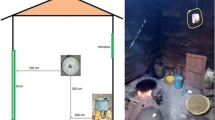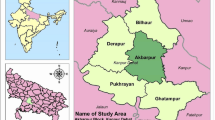Abstract
More than 85% of the rural Indian households use traditional solid biofuels (SBFs) for daily cooking. Burning of the easily available unprocessed solid fuels in inefficient earthen cooking stoves produce large quantities of particulate matters. Smaller particulates, especially with aerodynamic diameter of 2.5 μm or less (PM2.5), largely generated during cooking, are considered to be health damaging in nature. In the present study, kitchen level exposure of women cooks to fine particulate matters during lunch preparation was assessed considering kitchen openness as surrogate to the ventilation condition. Two-way ANCOVA analysis considering meal quantity as a covariate revealed no significant interaction between the openness and the seasons explaining the variability of the personal exposure to the fine particulate matters in rural kitchen during cooking. Multiple linear regression analysis revealed the openness as the only significant predictor for personal exposure to the fine particulate matters. In the present study, the annual average fine particulate matter exposure concentration was found to be 974 μg m−3.


Similar content being viewed by others

References
Albalak R, Frisancho AR, Keeler GJ (1999) Domestic biomass fuel combustion and chronic bronchitis in two rural Bolivian villages. Thorax 54:1004–1008
Balakrishnan K, Ghosh S, Ganguli B, Sambandam S, Bruce N, Barnes DF, Smith KR (2013) State and national household concentrations of PM2.5 from solid cook fuel use: results from measurements and modelling in India for estimation of the global burden of disease. Environ Health 12:77
Banerjee A, Mondal NK, Das D, Ray MR (2012) Neutrophilic inflammatory response and oxidative stress in premenopausal women chronically exposed to indoor air pollution from biomass burning. Inflammation 35:671–683
Bartington SE, Bakolis I, Devakumar D, Kurmi OP, Gulliver J, Chaube G, Manandhar DS, Savill NM, Costello A, Osrin D, Hansell AL (2017) Patterns of domestic exposure to carbon monoxide and particulate matter in households using biomass fuel in Janakpur, Nepal. Environ Pollut 220:38–45
Baumgartner J, Schauer JJ, Ezzati M, Lu L, Cheng C, Patz J, Bautista LE (2011) Patterns and predictors of personal exposure to indoor air pollution from biomass combustion among women and children in rural China. Indoor Air 21:479–488
Bhattacharya SC, Salam PA (2002) Low greenhouse gas biomass options for cooking in the developing countries. Biomass Bioenergy 22:305–317
Boman C, Nordin A, Boström D, Öhman M (2004) Characterization of inorganic particulate matter from residential combustion of pelletized biomass fuels. Energy Fuel 18:338–348
Census of India (2011) http://censusindia.gov.in/2011-common/nsdi/houses_household.pdf Accessed 20.06.2016
Cynthia AA, Edwards RD, Johnson M, Zuk M, Rojas L, Jiménez RD, Riojas-Rodriguez H, Masera O (2008) Reduction in personal exposures to particulate matter and carbon monoxide as a result of the installation of a Patsari improved cook stove in Michoacan Mexico. Indoor Air 18:93–105
Dasgupta S, Wheeler D, Hug M, Khaliquzzaman M (2009) Improving indoor air quality for poor families: a controlled experiment in Bangladesh. Indoor Air 19:22e32
Devakumar D, Semple S, Osrin D, Yadav SK, Kurmi OP, Saville NM, Shrestha B, Manandhar DS, Costello A, Ayres JG (2014) Biomass fuel use and the exposure of children to particulate air pollution in southern Nepal. Environ Int 66:79–87
Dutta A, Mukherjee B, Das D, Banerjee A, Ray MR (2011) Hypertension with elevated levels of oxidized low-density lipoprotein and anticardiolipin antibody in the circulation of premenopausal Indian women chronically exposed to biomass smoke during cooking. Indoor Air 21:165–176
Elbayoumi M, Ramli NA, Md Yusof NFF, Yahaya ASB, Al Madhoun W, Ul-Saufie AZ (2014) Multivariate methods for indoor PM10 and PM2.5 modelling in naturally ventilated schools buildings. Atmos Environ 94:11–21
Eleanne DS, Van V, Kwakupoku A, Darby WJ, Patrick LK, Robin MW, Steven NC, Livesy A, Charles Z, Seth OA (2013) Personal exposures to fine particulate matter and black carbon in households cooking with biomass fuels in rural Ghana. Environ Res 127:40–48
Fullerton DG, Bruce N, Gordon SB (2008) Indoor air pollution from biomass fuel smoke is a major health concern in the developing world. Trans R Soci Trop Med Hyg 102:843–851
Goyal R, Khare M (2011) Indoor air quality modeling for PM10, PM2.5 and PM1.0 in naturally ventilated classrooms of an urban Indian school building. Environ Monit Assess 176:501–516
Jetter JJ, Kariher P (2009) Solid-fuel household cook stoves: characterization of performance and emission s. Biomass Bioenergy 33:294–305
Joseph S (1990) Guidelines for planning, monitoring and evaluating cook stove programmes, UNFAO: Community Forestry Field Manual 1. Available at: http://www.fao.org/docrep/u1310e/u1310e00.htm Accessed 20.06.2016
Massey D, Kulshrestha A, Taneja A (2013) Particulate matter concentrations and their related metal toxicity in rural residential environment of semi-arid region of India. Atmos Environ 67:278–286
Massey D, Masih J, Kulshrestha A, Habil M, Taneja A (2009) Indoor/outdoor relationship of fine particles less than 2.5mm (PM2.5) in residential homes locations in central Indian region. Build Environ 44:2037–2045
McCracken JP, Schwartz J, Diaz A, Bruce N, Smith KR (2013) Longitudinal relationship between personal CO and personal PM2.5 among women cooking with woodfired cookstoves in Guatemala. PLoS One 8:e55670
Mondal NK, Mukherjee B, Das D, Ray MR (2010) Micronucleus formation, DNA damage and repair in premenopausal women chronically exposed to high level of indoor air pollution from biomass fuel use in rural India. Mutat Res 697:47–54
Monteiller C, Tran L, MacNee W, Faux S, Jones A, Miller B, Donaldson K (2007) The pro-inflammatory effects of low-toxicity low-solubility particles, nanoparticles and fine particles, on epithelial cells in vitro: the role of surface area. Occup Environ Med 64:609–615
Mukhopadhyay R, Sambandam S, Pillarisetti A, Jack D, Mukhopadhyay K, Balakrishnan K, Vaswani M, Bates MN, Kinney PL, Arora N, Smith KR (2012) Cooking practices, air quality, and the acceptability of advanced cook stoves in Haryana, India: an exploratory study to inform large-scale interventions. Glob Health Action 5:19016
NAAQS, India (2009) http://cpcb.nic.in/National_Ambient_Air_Quality_Standards.php Accessed on 20.06.2016
NAAQS, USEPA (2012) https://www.epa.gov/criteria-air-pollutants/naaqs-table
Nayek S, Padhy PK (2017) Daily personal exposure of women cooks to respirable particulate matters during cooking with solid bio-fuels in a rural community of West Bengal, India. Aerosol Air Qual Res 17:245–252
Nussbaumer T, Czasch C, Klippel N, Johansson L, Tullin C (2008) Particulate emissions from biomass combustion in IEA countries. http://www.vbt.uni-karlsruhe.de/index.pl/themen/mahe_wirbel/literatur/Wood-Single-Aspects/Emissions/Partikulate-Emissions-from-Biomass-Combustion-in-IEA-Countries_Nussbaumer_IEA_2008.pdf Accessed 24.06.2016
Nussbaumer T (2003) Combustion and co-combustion of biomass: fundamentals, technologies, and primary measures for emission reduction. Energy Fuel 17:1510–1521
Parikh J, Balakrishnan K, Laxmi V, Biswas H (2001) Exposure from cooking with biofuels: pollution monitoring and analysis for rural Tamil Nadu, India. Energy 26:949–962
Pope CA III, Burnett RT, Thun MJ, Calle EE, Krewski D, Ito K, Thurston GD (2002) Lung cancer, cardiopulmonary mortality, and long-term exposure to fine particulate air pollution. JAMA 287:1132–1141
Pope CA III, Burnett RT, Turner MC, Cohen A, Krewski D, Jerrett M, Gapstur SM, Thun MJ (2011) Lung cancer and cardiovascular disease mortality associated with ambient air pollution and cigarette smoke: shape of the exposure-response relationships. Environ Health Persp 119:1616–1621
Prasad R, Singh A, Garg R, Hosmane GB (2012) Biomass fuel exposure and respiratory diseases in India. Biosci Trends 6:219–228
Ray MR, Mukherjee S, Roychoudhury S, Bhattacharya P, Banerjee M, Siddique S, Chakraborty S, Lahiri T (2006) Platelet activation, upregulation of CD11b/CD18 expression on leukocytes and increase in circulating leukocyte-platelet aggregates in Indian women chronically exposed to biomass smoke. Hum Exp Toxicol 25:627–635
Reddy MS, Venkataraman C (2002) Inventory of aerosol and Sulphur dioxide emissions from India. Part II—biomass combustion. Atmos Environ 36:699–712
Risom L, Møller P, Loft S (2005) Oxidative stress-induced DNA damage by particulate air pollution. Mutat Res Fund Mol Mech Mut 592:119–137
Roden CA, Bond TC, Conway S, Pinel ABO, MacCarty N, Still D (2009) Laboratory and field investigations of particulate and carbon monoxide emissions from traditional and improved cook stoves. Atmos Environ 43:1170–1181
Satsangi PG, Yadav S, Pipal AS, Kumbhar N (2014) Characteristics of trace metals in fine (PM 2.5) and inhalable (PM 10) particles and its health risk assessment along with in-silico approach in indoor environment of India. Atmos Environ 92:384–393
Shen G, Xue M (2014) Comparison of carbon monoxide and particulate matter emissions from residential burnings of pelletized biofuels and traditional solid fuels. Energy Fuel 28:3933–3939
Shen G, Tao S, Chen Y, Zhang Y, Wei S, Xue M, Wang B, Wang R, Lu Y, Li W, Shen H (2013) Emission characteristics for polycyclic aromatic hydrocarbons from solid fuels burned in domestic stoves in rural China. Environ Sci Technol 47:14485–14494
Shrestha IL, Shrestha SL (2005) Indoor air pollution from biomass fuels and respiratory health of the exposed population in Nepalese households. Int J Occup Med Environ Health 11:150–160
Siddiqui AR, Lee K, Bennett D, Yang X, Brown KH, Bhutta ZA, Gold EB (2009) Indoor carbon monoxide and PM2.5 concentrations by cooking fuels in Pakistan. Indoor Air 19:75–82
Sinha SN, Kulkarni PK, Shah SH, Desai NM, Patel GM, Mansuri MM, Saiyed HN (2006) Environmental monitoring of benzene and toluene produced in indoor air due to combustion of solid biomass fuels. Sci Total Environ 357:280–287
Smith KR, Peel JL (2010) Mind the gap. Environ Health Persp 118:1643–1645
Smith KR, Mehta S, Maeusezahl-Feuz M (2004) Indoor smoke from household solid fuels. In: Ezzati M, Rodgers A, Lopez AD, Hoorn SV, Murray CJL, Eds. Comparative quantification of health risks: global and regional burden of disease attributable to selected major risk factors. Geneva: World Health Organization 2:1435–1493
Tielsch JM, Katz J, Thulasiraj RD, Coles CL, Sheeladevi S, Yanik EL, Rahmathullah L (2009) Exposure to indoor biomass fuel and tobacco smoke and risk of adverse reproductive outcomes, mortality, respiratory morbidity and growth among new-born infants in South India. Int J Epidemiol 38:1351–1363
Titcombe ME, Simcik M (2011) Personal and indoor exposure to PM2.5 and polycyclic aromatic hydrocarbons in the southern highlands of Tanzania: a pilot-scale study. Environ Mon Assess 180:461–476
Van Vliet ED, Asante K, Jack DW, Kinney PL, Whyatt RM, Chillrud SN, Abokyi L, Zandoh C, Owusu-Agyei S (2013) Personal exposures to fine particulate matter and black carbon in households cooking with biomass fuels in rural Ghana. Environ Res 127:40–48
Venkataraman C, Habib G, Eiguren-Fernandez A, Miguel AH, Friedlander SK (2005) Residential biofuels in South Asia: carbonaceous aerosol emissions and climate impacts. Science 307:1454–1456
WHO (2006) www.euro.who.int/__data/assets/pdf_file/0008/147851/E87950.pdf Accessed 20.06.2016
Williams A, Jones JM, Ma L, Pourkashanian M (2012) Pollutants from the combustion of solid biomass fuels. Prog Energy Combust Sci 38:113–137
Yip F, Christensen B, Sircar K, Naeher L, Bruce N, Pennise D, Lozier M, Pilishvili T, Farrar JL, Stanistreet D, Nyagol R (2017) Assessment of traditional and improved stove use on household air pollution and personal exposures in rural western Kenya. Environ Int 99:185–191
Zhang J, Smith KR, Ma Y, Ye S, Jiang F, Qi W, Liu P, Khalil MAK, Rasmussen RA, Thorneloe SA (2000) Greenhouse gases and other airborne pollutants from household stoves in China: a database for emission factors. Atmos Environ 34:4537–4549
Zuk M, Rojas L, Blanco S, Serrano P, Cruz J, Angeles F, Tzintzun G, Armendariz C, Edwards RD, Johnson M, Riojas-Rodriguez H (2007) The impact of improved wood-burning stoves on fine particulate matter concentrations in rural Mexican homes. J Expo Sci Environ Epidemiol 17:224–232
Acknowledgements
The fellowships provided in the form of Junior Research Fellow (JRF) and Senior Research Fellow (SRF) by the Innovation in Science Pursuit for Inspired Research (INSPIRE), Department of Science and Technology, Government of India, New Delhi to the first author is gratefully acknowledged. Supports from the studied households of the study area are also acknowledged heartily. We also thank the anonymous reviewers and the editor for their helpful comments and suggestions on this MS.
Author information
Authors and Affiliations
Corresponding author
Ethics declarations
Conflict of interest
The authors declare that they have no conflict of interest.
Additional information
Responsible editor: Philippe Garrigues
Rights and permissions
About this article
Cite this article
Nayek, S., Padhy, P.K. Approximation of personal exposure to fine particulate matters (PM2.5) during cooking using solid biomass fuels in the kitchens of rural West Bengal, India. Environ Sci Pollut Res 25, 15925–15933 (2018). https://doi.org/10.1007/s11356-018-1831-7
Received:
Accepted:
Published:
Issue Date:
DOI: https://doi.org/10.1007/s11356-018-1831-7



